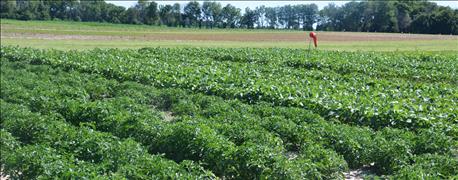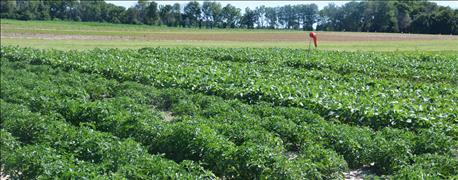
When Dow AgroSciences introduced the concept of applying 2,4-D over corn and soybeans carrying a gene resistant to the herbicide, some of the most nervous people around were tomato growers. Tomatoes are very sensitive to 2,4-D if volatilization or drift occurs, and the herbicide carries from a target corn or soybean field to a nearby tomato field.

DEMO PROVES POINT: Tomatoes growing in this plot were virtually unharmed when Enlist Duo herbicide was sprayed on downwind, adjacent Enlist soybeans, following label instructions.
That’s why it was puzzling to follow Jonathan Siebert down an aisle at the Dow AgroSciences demonstration farm near Sheridan last summer and find a plot of tomatoes growing side by side with soybeans. Siebert is the Enlist Weed Control System sales leader. What’s more, a signboard indicated that Red Gold, a major tomato-processing company, cooperated in the demonstration project. What changed the attitude from being nervous about the Enlist technology to being supportive of demonstrating how it works?
New technology
The answer is all about the new technology Dow AgroSciences developed for the Enlist Weed Control System, Siebert says. After tons of research time in the lab, Dow AgroSciences researchers developed a formulation of 2,4-D that barely resembles the original herbicide in terms of properties.
“It’s all about the Colex-D technology in the formulation,” Siebert notes. “Off-target movement is less of a concern.”
What farmers need to realize, Siebert says, is that Enlist Duo herbicide that can be applied over Enlist corn and Enlist soybeans with resistance to 2,4-D does not move off-target easily, and does not volatize easily either. “There is near-zero volatility with this formulation,” he says.
Dow AgroSciences and Red Gold cooperated to put out the plot of tomatoes growing right next to the soybeans to prove that point. A couple of rows of soybeans without the Enlist trait were included to show the effect on plants without resistance, and to illustrate how minimal any off-target movement is. The Enlist soybeans were sprayed with Enlist Duo at the time a normal application would be made. The tomatoes would have been sensitive to off-target movement.
Lack of damage to the tomatoes proved the claim to be true. Leaves weren’t affected, and the plants grew normally. There was virtually no off-target movement into the tomato plot from the Enlist Duo application, Siebert says.
Future use
The key will be following label directions whenever Enlist Duo is applied, Siebert says. The label specifies acceptable conditions for application.
It also specifies that only Enlist Duo with Colex-D technology is approved for application on Enlist corn and Enlist soybeans. Attempting to apply any other form of 2,4-D would make the application off-label and illegal, he notes.
It’s the technology behind the formulation that was developed in the lab that makes all the difference, he says. That’s what allows an application to be made near a sensitive crop such as tomatoes without risking injury.
About the Author(s)
You May Also Like




